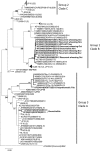Respiratory Infections by Enterovirus D68 in Outpatients and Inpatients Spanish Children
- PMID: 26741582
- PMCID: PMC4677598
- DOI: 10.1097/INF.0000000000000908
Respiratory Infections by Enterovirus D68 in Outpatients and Inpatients Spanish Children
Abstract
Background: The incidence of enterovirus D68 (EV-D68) and the spectrum of clinical disease in children are not well known in European countries. We have designed a study with the objective of describing the clinical impact of EV-D68 detected in children with respiratory tract infections.
Methods: As a part of a prospective study to identify the etiology and clinical characteristics of viral respiratory infections in children in Spain, we performed the analysis of the cases of EV infections in all children hospitalized in a secondary hospital in Madrid, during the epidemic respiratory season 2012-2013. A second group of samples was corresponded to infants of the same area, with ambulatory respiratory infection or asymptomatic. Phylogenetic EV-D68 analysis was made using the viral protein 1 gene (VP1). Clinical data of EV-D68 patients were compared with those infected by rhinovirus in the same period and population.
Results: The study population consisted of 720 patients corresponding to 399 episodes of hospitalization for respiratory causes, 44 episodes of ambulatory respiratory infections and 277 children determined as a healthy control group. A total of 22 patients were positive for EVs (3.05%), and 12 of them were specifically typed as EV-D68 (11/443 respiratory infections, 2.5%). The most frequent diagnosis in the 10 hospitalized children with EV-D68 detection was recurrent wheezing. Hypoxia was present in 70% of cases, but admission in the intensive care unit was not required. No neurological signs or symptoms were observed. One patient had an ambulatory mild bronchiolitis and another was asymptomatic. No differences were found with rhinovirus infections except less duration of hypoxia and fever in EV-D68 group.
Conclusions: EV-D68 infections were detected in 3.05% of respiratory studied samples (2.5% of admissions). The infection was associated with wheezing episodes with hypoxia. No admissions to intensive care unit or neurological symptoms were found.
Conflict of interest statement
This study has been partially supported by FIS (Fondo de Investigaciones Sanitarias—Spanish Health Research Fund) Grant No: PI12/01291 and I Research grant from the Spanish Association of Pediatrics. The authors have no conflicts of interest to disclose.
Figures

Similar articles
-
Coexistence of two clades of enterovirus D68 in pediatric Swedish patients in the summer and fall of 2014.Infect Dis (Lond). 2015;47(10):734-8. doi: 10.3109/23744235.2015.1047402. Epub 2015 May 14. Infect Dis (Lond). 2015. PMID: 25972105
-
Severe enterovirus 68 respiratory illness in children requiring intensive care management.J Clin Virol. 2015 Sep;70:77-82. doi: 10.1016/j.jcv.2015.07.298. Epub 2015 Jul 20. J Clin Virol. 2015. PMID: 26305825
-
Clinical characteristics of children infected with enterovirus D68 in an outpatient clinic and the association with bronchial asthma.Infect Dis (Lond). 2018 Apr;50(4):303-312. doi: 10.1080/23744235.2017.1400176. Epub 2017 Nov 9. Infect Dis (Lond). 2018. PMID: 29119851
-
Global reemergence of enterovirus D68 as an important pathogen for acute respiratory infections.Rev Med Virol. 2015 Mar;25(2):102-14. doi: 10.1002/rmv.1820. Epub 2014 Dec 3. Rev Med Virol. 2015. PMID: 25471236 Free PMC article. Review.
-
Enterovirus D68 in Hospitalized Children, Barcelona, Spain, 2014-2021.Emerg Infect Dis. 2022 Jul;28(7):1327-1331. doi: 10.3201/eid2807.220264. Emerg Infect Dis. 2022. PMID: 35731133 Free PMC article. Review.
Cited by
-
Clinical characteristics and outcomes of human rhinovirus positivity in hospitalized children.Ann Thorac Med. 2018 Oct-Dec;13(4):230-236. doi: 10.4103/atm.ATM_291_17. Ann Thorac Med. 2018. PMID: 30416595 Free PMC article.
-
Enterovirus D68 Infection Among Children With Medically Attended Acute Respiratory Illness, Cincinnati, Ohio, July-October 2014.Clin Infect Dis. 2017 Jul 15;65(2):315-323. doi: 10.1093/cid/cix314. Clin Infect Dis. 2017. PMID: 28379349 Free PMC article.
-
Clinical Presentation of Enterovirus D68 in a Swiss Pediatric University Center.Pediatr Infect Dis J. 2024 Aug 14;43(12):1135-40. doi: 10.1097/INF.0000000000004503. Online ahead of print. Pediatr Infect Dis J. 2024. PMID: 39163309 Free PMC article.
-
Enterovirus D-68 in children presenting for acute care in the hospital setting.Influenza Other Respir Viruses. 2018 Jul;12(4):522-528. doi: 10.1111/irv.12551. Epub 2018 Mar 23. Influenza Other Respir Viruses. 2018. PMID: 29498483 Free PMC article.
-
Enterovirus D68-associated respiratory and neurological illness in Spain, 2014-2018.Emerg Microbes Infect. 2019;8(1):1438-1444. doi: 10.1080/22221751.2019.1668243. Emerg Microbes Infect. 2019. PMID: 31571527 Free PMC article.
References
-
- Schieble JH, Fox VL, Lennette EH. A probable new human picornavirus associated with respiratory diseases. Am J Epidemiol. 1967;85:297–310. - PubMed
-
- Meijer A, van der Sanden S, Snijders BE, et al. Emergence and epidemic occurrence of enterovirus 68 respiratory infections in The Netherlands in 2010. Virology. 2012;423:49–57. - PubMed
Publication types
MeSH terms
Substances
LinkOut - more resources
Full Text Sources
Other Literature Sources
Research Materials

